25. Hiking, Steering and Rig Control |
By Ian Ainslie
|
|
The Finn may not be your modern 'crash and burn' speedster, but technically, tactically or physically it is still the most demanding boat to sail well. The hull is heavy by modern standards and this requires a special 'oneness' with the boat. 'Bouncing' around, like you would in a Laser is not as efficient as moving in harmony with the natural frequencies of the boat. This may explain why anyone who has sailed a Finn for some time will always have a very soft spot for the boat.
Hiking
After 8 years of sailing Finns (and trying to fool myself) I am now in a position to offer advice for 99% of speed problems in over 10 knots of wind. My advice is this: 'hike like a beast'. Dave Hibberd and I have our standard joke when it's breezy, about 'proving our beasthood' or 'flaunting our beasthood'. Dinghy sailors have been very slow in realising the huge benefits of physical fitness and strength.
|
 |
I followed a program of strength building and stretching when I wasn't sailing, but I found that the best strength training for Finn sailing, and the most fun, was Finn sailing. It is, however, important to warm up and stretch before you sail to prevent stiffness and injury. In addition to stretching, a massage of thighs, lower back and shoulders can also be tremendously beneficial in relieving stiffness before a race.
Hiking Equipment
A lot of Finn sailors think that pain is an integral part of hiking. This is not so. You have to arrange your hiking pads, pad your toestraps etc., so that loads are evenly distributed and circulation is not cut off. My wetsuits have hiking battens built into the back of the leg. These are absolutely essential for hiking comfort. You are only going to improve your hiking if you are able to extend your muscles to exhaustion and not having to ease off because of pain due to improper equipment. |
|
Hiking Techniques
There are several different ways to hike on a Finn from straight-legged to drooped. Because the boat has a relatively high freeboard, the actual style is not as important as getting as much of your body away from the boat as possible. I prefer to hike straight-legged because I feel that I am taller and lighter than average, and this gives me the best leverage to move the boat around with my upper body. There are disadvantages associated with having very loose toestraps, like having your mainsheet running over the top of them. The most popular hiking stance of the fast sailors is in between the two extremes: knees bent at about 120 degrees but not having the butt slumped too far under the boat.
Body Movements
You will have to develop some very controlled and subtle body movements to get the boat moving over a chop well. To get the boat to head up, allow a slight heel and let the tiller ease down on its own to bring the bow into the wind. This is also achieved by rotating the boat with your body. When I am hiking, I like to imagine the boat as being part of the back of my knees (which are on the side-deck). To get the boat to head up, I swivel the boat around the fulcrum of my legs by swinging my shoulders back. This puts pressure on the front of my toestrap and also pulls the bow up. To bear off, I swing forward again to push the bow away from the wind while pulling the stern to weather with my back foot in the toestrap. This coincides with the need to lift the bow on the face of an approaching chop and getting it back into the water on the top of the wave (before it can pound down). |
The Rudder is a Brake!
My favourite conditions are offwind in a big swell. Styles vary but compared with most of my competitors I find that I tend to move around a lot more but tend not to pump as much. I also tend to make much bigger course alterations. Sometimes I am able to make dramatic gains by doing this. On other occasions, I have noticed that the sailors who don't steer around that much but just pump hard on each wave to catch a short surf end up sailing a much shorter distance. The difference seems to be determined by whether I am able to plane as well as surf.
Once I am moving fast, I can use the pressure to ride the wave way below the rhumb line. Before I lose the wave, I bring the boat up again so that there is a lot of pressure in the rig. As the next wave approaches, you are not 'low and slow', so you can hook on to it and catch the next ride.
The reason why my movements in the boat are more extreme is that, in order to change course so much, you have to steer with your body. You have to let the tiller follow the boat around and not be resisting you at all. As important as the sideways movement is balancing the boat fore and aft to get the bow the right height out of the water. Encourage the stern to lift as the wave approaches and then shoot back to stop the bow from pushing water as you hook on to the wave. All these movements have got to be controlled, fluid and instinctive. |
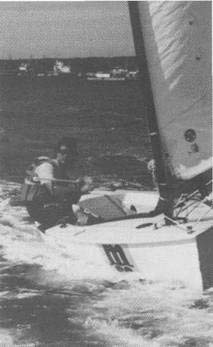 |
|
Playing the Mainsheet
It is better to play the sheet directly off the boom, without purchase, because this allows your arm movements to be smaller, and the control to be more direct. Of course, you have to be strong enough, otherwise you will not be able to move the sail all the time with each variation in speed pressure and course.
My shoulders are angled forward with the tiller extension held out in front of my body so that it doesn't get in the way of the rapid movements. My forward leg is under the toestrap, angled forward, positioned to shoot my body back by pushing against the ratchet block on the cockpit floor. My back leg is mostly bent, so that my heel is able to push against the side of the cockpit, so that I am ready to quickly move my weight inboard.
|
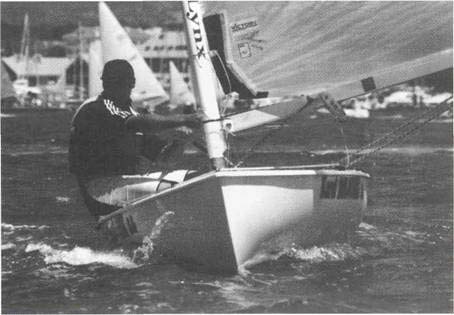 |
The only way to get all these movements right is to go out and play in the waves!
Simple Rig Principles
The modern Finn is so adjustable that a very wide variety of body weights and sailing styles are able to go fast over a range of conditions. The carbon fibre masts are extremely powerful in moderate conditions yet tend to whip around more in a big breeze and chop. It is a challenge to master the awesome rig. It almost always generates too much power and incorrect setup can have you hating life. It is a matter of understanding a few simple principles and exploring the effects of the various sail controls. |
|
Sail Controls
Mainsheet: This is the control that you will adjust the most in light/moderate conditions. As you sheet in, the mast bends and this will the overall fullness of the sail as well as the leech tension. Generally you sheet the boom onto the deck as soon as you are completely overpowered.
Traveller: A general guide to the traveller position is that the back end of your boom should be in line with the side of the boat. The traveller will be further eased as you become overpowered. I tend to adjust my traveller more often than most. In strong winds and big chop I will play the control all the time. Most sailors prefer to leave the traveller more static and allow the mast to alter the boat's power.
Tack in-haul: Easing the tack will have the effect of flattening the entry of the sail low down (especially if you tension the outhaul simultaneously) and tightening the lower leech. This is a prerequisite for pointing high, while tensioning the tack control will depower the sail, especially by opening the lower leech. (You will notice that the angle of the lower batten will change). The exact position of the tack is dependent on how much the sailmaker has cut the tack away.
Cunningham: Tensioning the Cunningham depowers the sail by moving cloth from the middle of the sail towards the luff and thereby opening the leech. Because the chord is shortest at the top of the sail, the biggest effect is seen high up. The Cunningham becomes an important control when you are constantly shifting between the pinching mode and the footing or 'scooting' mode. As soon as you want to go fast, albeit lower, pulling on the Cunningham eases pressure on the helm, gets the leech to twist and allows you to sail lower but much faster.
Outhaul: This controls the overall fullness of the sail, especially in the lower third.
Vang: The vang is very seldom used upwind. Occasionally I use it to bend the mast in light and lumpy conditions. I can then really change the angle of the boom a lot by using the mainsheet, without allowing the sail to become too full. For offwind I will tension the vang just enough to get a powerful leech without starting to bend the mast - a bit less in light airs and a bit more in a breeze. If you ever find yourself close reaching in a big breeze, you'll have to ease the vang to depower and prevent the boom from hitting the water. |
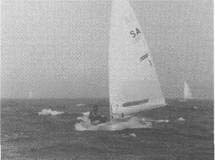 |
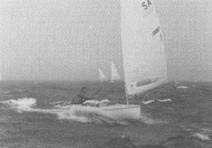 |
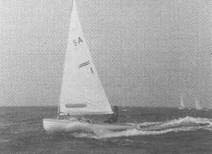 |
|
Luff Curve
Once you fully understand the effects of all the sail controls, you have to work with a sailmaker in order to match your sail luff curve to your mast's bend. By studying other people's rigs and really getting to know yours well, you will develop an eye for what you are looking for.
You will be able to know whether the sail/mast combination is in the ball park by going for a brief sail. Too little luff curve at some point on the sail will show up easily enough. You'll see wrinkles running from that spot on the luff to the clew. Too much luff curve is harder to spot but is more serious, especially in the lower half of the sail. Excess cloth near the mast makes it hard to open your leech, which will over-power you in a breeze and the roundness in the front will make it difficult to point in moderate winds.
The best way to check your mast/sail match is to get someone to swap boats with you in about 10-12 knots. Position yourself behind and to leeward of your boat so that you just able to sight down the leeward side of the mast's sail track. The sail track will be obscured in places where there is relatively too much luff curve.
|
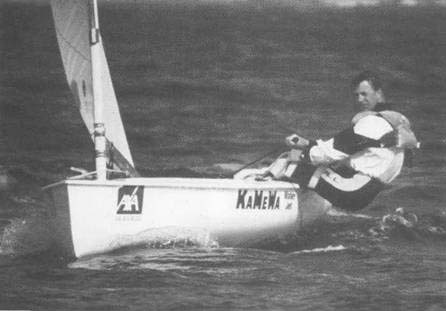
|
Mast Bend Characteristics.
There are about as many theories on masts as there are Finn sailors. When it comes to masts, most sailors are fashion conscious. I think that you should understand the basics and not get over technical. You only have to see the massive differences in boatspeed in the Laser class to realise that sailing technique makes the biggest difference to speed.
Sideways Mast Bend
The sideways stiffness is going to affect the sail's twist and the rig's power. A soft mast will make the boat easy to sail upwind in a breeze but you will not point well and you will also lack power as the breeze lightens up. Remember, the harder you hike, the greater the sideways force will be on the rig and the more the mast will bend off. So, before you convince yourself that there is too much power in the rig, make sure that you are hiking hard enough. |
|
As far as the sideways profile goes, I prefer a mast that comes out of the deck straightish and only starts falling away above the half height, progressively bending more to the tip. The bend should be smooth (no 'hinge' points), with the tip working the most in puffs and waves.
Fore & Aft Mast Bend
Without the need for all the sleeves found on the old aluminium masts, the carbon masts have a much more even bend. In general, you can either have a mast which is bendy in the ends or one which is bendy in the middle. The former is normally easier to use and is superior in lighter winds because it allows the leech to open more easily. The latter gives you better control over leech tension in a breeze and, when combined with a flattish sail, is faster upwind in these conditions. However, you are normally raked further back so it is not as quick offwind.
|
Mast Rake
Adjusting the rake affects the amount of leech tension you have once you have sheeted the ' boom on to the deck. If your mast is too upright, this will cause too much leech tension and the boat will be staggering around in the puffs and chop. Too little leech tension and you will not be able to point. The exact measurement will vary from rig to rig but around 6.80 m measured between top black band and transom will get you in the ball park. When I was using a Hall spar, I was up at 6.86 m in a breeze because it was relatively soft down low whereas the mast I use now, is very stiff below the deck and I can't get up more than 6.80 in a breeze and 6.76 in lighter winds. On my boat, I have a track with a slide to adjust the rake at deck level. I use just two holes on the plunger - back for light winds, upright for medium to strong winds and then back again in extremely strong winds.
|
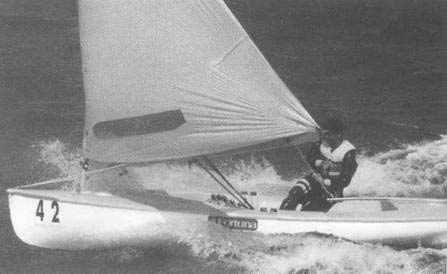 |
|
|